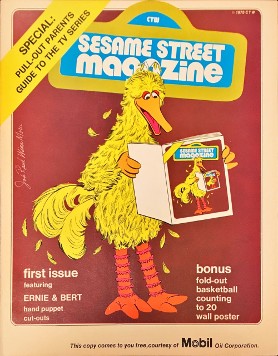Sesame Street Magazine facts for kids

Cover of the first issue, published in 1970
|
|
| Editor-in-chief | Rebecca Herman |
|---|---|
| Staff writers | Beth Sharkey |
| Categories | Children's literature |
| Frequency | Monthly |
| Publisher | Sesame Workshop |
| Total circulation (2006) |
650,000 |
| First issue | October 1970 |
| Company | The Parenting Group |
| Based in | New York City |
| Language | English |
| ISSN | 0049-0253 |
Sesame Street Magazine was a popular American magazine. It was published every month and was based on the famous TV show Sesame Street. The magazine featured all your favorite characters from the show. It also focused on the important learning goals that Sesame Street always had. The magazine was made for young children (under five) and their parents.
Sesame Workshop, which used to be called the Children's Television Workshop, first published the magazine. They started in October 1970 and continued until 2001. After that, a company called The Parenting Group took over. From 2001 to 2008, they offered the magazine to people who subscribed to Parenting magazine. Since 2008, The Parenting Group has shared Sesame Street Magazine online for free. The magazine won the Parents' Choice Award 18 times between 1970 and 2007. This award recognizes excellent children's media.
Contents
What Was Inside Sesame Street Magazine?
In 1985, the magazine's publisher, Nina Link, had an idea. She wanted to add a special guide for parents into the magazine. This idea grew into a separate magazine called Sesame Street Parents' Guide. This guide helped parents understand what their children could learn from each issue. It explained the main topics of the children's magazine. People who subscribed to Sesame Street Magazine received both publications. The children's magazine did not have outside advertisements. However, the Parents' Guide did.
Both the children's magazine and the parents' guide worked with the TV show. Every year, the Children's Television Workshop created new learning goals. These goals were used for both the TV show and the magazine. For example, if the show talked about the environment, the magazine would too.
Nina Link, who was the publisher from 1978 to 1999, explained the magazine's purpose. Renée Cherow-O’Leary, who worked on research for the magazine from 1989 to 1995, also helped set the guidelines. They said:
Sesame Street Magazine is designed to be a child's first magazine. It seeks to encourage the development of literacy, inquisitiveness, and social skills. Each issue is organized around a central theme. One month it might be a concept such as number, color, or shape recognition; another month it might be a psychological theme such as a child's need for self-esteem. The magazine has regular departments and features in which many familiar Sesame Street television characters (e.g., Big Bird, Grover, and the Cookie Monster) appear. In addition, photo essays cover real-life issues, such as what it is like to have a pet, use a wheelchair, or visit the library."
The magazine aimed to help kids learn important skills. These included reading, writing, math, and social skills. Just like the Sesame Street TV show, the magazine was also studied. Experts checked how well the magazine helped children learn. The goal was always to mix education with fun. So, the magazine had stories with characters like Big Bird and Cookie Monster. It also used bright, engaging colors.
The Sesame Street Parent's Guide also had a clear goal. Nina Link and Renee Cherow-O'Leery explained its purpose:
It is to help parents better understand the changing needs of their preschool children. The magazine offers practical parenting advice and features articles on health, safety, nutrition, and the latest research on child development. A regular department,"Extending This Issue," gives parents suggestions on how to use the accompanying Sesame Street Magazine to expand their child's learning potential.
How Many People Read It?
Sesame Street Magazine was very popular. In 1981, over 1.1 million copies were sold. About 375,000 of these were bought at newsstands. A yearly subscription cost $6.95 for 10 issues. A single issue cost 75 cents.
By 1990, the magazine's readership reached its highest point. About 1.2 million copies were sold. A one-year subscription then cost $14.95 for 10 issues. A single issue cost $1.50. At this time, subscriptions included the Parent's Guide. However, the guide was not sold separately at newsstands. An extra 51,000 copies of both magazines were sent for free. These went to doctors' offices for kids to read.
In 1999, the magazine still had a large number of readers. Over 1.1 million copies were paid for in the first half of the year. An additional 16,000 copies were given away for free.
By 2000, the number of paid readers dropped slightly. It was about 1.1 million copies in the first half of that year. As of 2006, a subscription cost $12.00 for 11 issues. This was often ordered through Parenting magazine.
How the Magazine Helped Kids Learn
Sesame Street Magazine was even used in schools. A preschool in New Brunswick, New Jersey, used it for its learning program. The school based its monthly lessons on the magazine's themes. At the end of each month, students took a magazine home. This helped connect what kids learned at school with their parents. It encouraged parents to talk about the lessons with their children. The publisher, Nina Link, even donated copies of the magazine to the school.
Other Magazines Like It
- Kid City: This magazine was made for children aged 6–10. It was for kids who had grown too old for Sesame Street Magazine. Children's Television Workshop also produced it. Each issue focused on a different theme, just like Sesame Street Magazine.
- 3-2-1 Contact: This was a science magazine. It was based on the Children's Television Workshop TV show of the same name. It was made for kids aged 8–14.
- Creative Classroom: Children's Television Workshop bought this magazine in 1990. It was created for elementary school teachers.
(archived)

